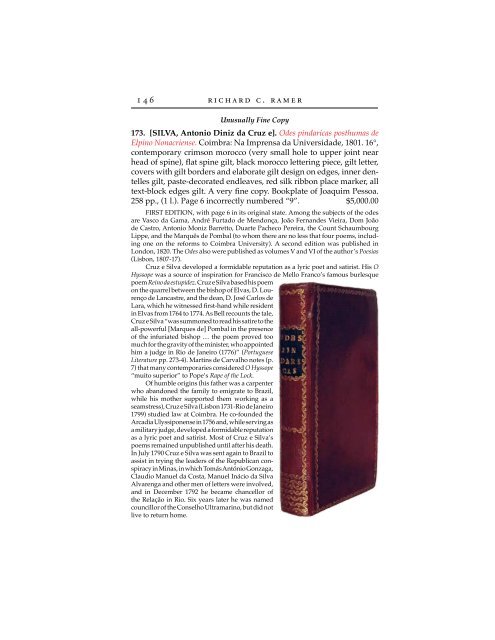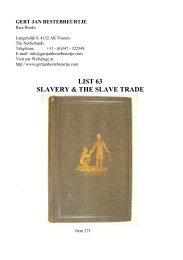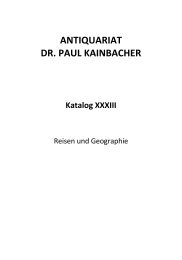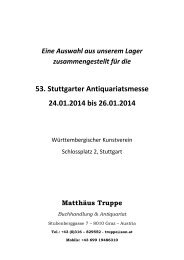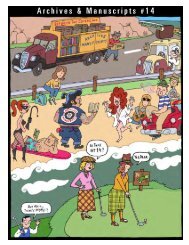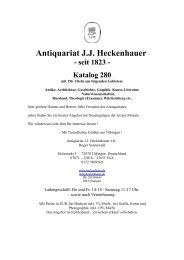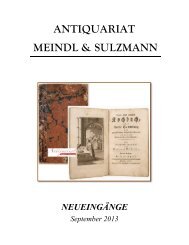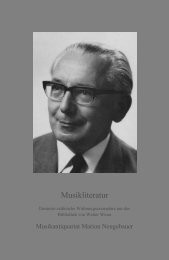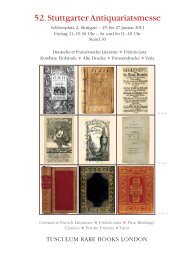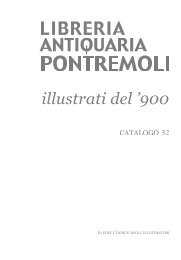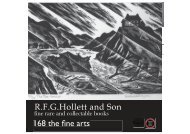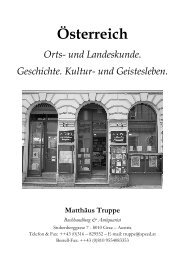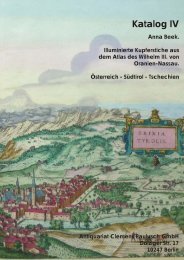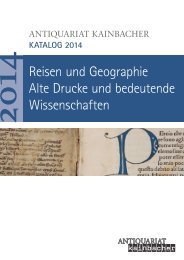Recent Acquisitions - Richard C. Ramer Old & Rare Books
Recent Acquisitions - Richard C. Ramer Old & Rare Books
Recent Acquisitions - Richard C. Ramer Old & Rare Books
You also want an ePaper? Increase the reach of your titles
YUMPU automatically turns print PDFs into web optimized ePapers that Google loves.
146<br />
richard c. ramer<br />
Unusually Fine Copy<br />
173. [SILVA, Antonio Diniz da Cruz e]. Odes pindaricas posthumas de<br />
Elpino Nonacriense. Coimbra: Na Imprensa da Universidade, 1801. 16°,<br />
contemporary crimson morocco (very small hole to upper joint near<br />
head of spine), flat spine gilt, black morocco lettering piece, gilt letter,<br />
covers with gilt borders and elaborate gilt design on edges, inner dentelles<br />
gilt, paste-decorated endleaves, red silk ribbon place marker, all<br />
text-block edges gilt. A very fine copy. Bookplate of Joaquim Pessoa.<br />
258 pp., (1 l.). Page 6 incorrectly numbered “9”. $5,000.00<br />
FIRST EDITION, with page 6 in its original state. Among the subjects of the odes<br />
are Vasco da Gama, André Furtado de Mendonça, João Fernandes Vieira, Dom João<br />
de Castro, Antonio Moniz Barretto, Duarte Pacheco Pereira, the Count Schaumbourg<br />
Lippe, and the Marquês de Pombal (to whom there are no less that four poems, including<br />
one on the reforms to Coimbra University). A second edition was published in<br />
London, 1820. The Odes also were published as volumes V and VI of the author’s Poesias<br />
(Lisbon, 1807-17).<br />
Cruz e Silva developed a formidable reputation as a lyric poet and satirist. His O<br />
Hyssope was a source of inspiration for Francisco de Mello Franco’s famous burlesque<br />
poem Reino da estupidez. Cruz e Silva based his poem<br />
on the quarrel between the bishop of Elvas, D. Lourenço<br />
de Lancastre, and the dean, D. José Carlos de<br />
Lara, which he witnessed first-hand while resident<br />
in Elvas from 1764 to 1774. As Bell recounts the tale,<br />
Cruz e Silva “was summoned to read his satire to the<br />
all-powerful [Marques de] Pombal in the presence<br />
of the infuriated bishop … the poem proved too<br />
much for the gravity of the minister, who appointed<br />
him a judge in Rio de Janeiro (1776)” (Portuguese<br />
Literature pp. 273-4). Martins de Carvalho notes (p.<br />
7) that many contemporaries considered O Hyssope<br />
“muito superior” to Pope’s Rape of the Lock.<br />
Of humble origins (his father was a carpenter<br />
who abandoned the family to emigrate to Brazil,<br />
while his mother supported them working as a<br />
seamstress), Cruz e Silva (Lisbon 1731-Rio de Janeiro<br />
1799) studied law at Coimbra. He co-founded the<br />
Arcadia Ulyssiponense in 1756 and, while serving as<br />
a military judge, developed a formidable reputation<br />
as a lyric poet and satirist. Most of Cruz e Silva’s<br />
poems remained unpublished until after his death.<br />
In July 1790 Cruz e Silva was sent again to Brazil to<br />
assist in trying the leaders of the Republican conspiracy<br />
in Minas, in which Tomás António Gonzaga,<br />
Claudio Manuel da Costa, Manuel Inácio da Silva<br />
Alvarenga and other men of letters were involved,<br />
and in December 1792 he became chancellor of<br />
the Relação in Rio. Six years later he was named<br />
councillor of the Conselho Ultramarino, but did not<br />
live to return home.


